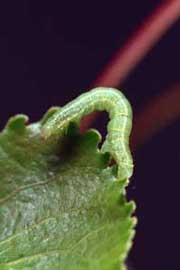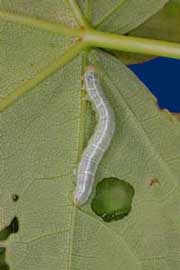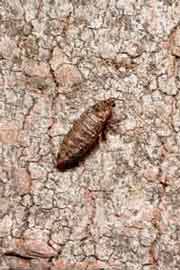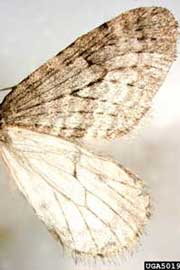Bruce Spanworm—Operophtera bruceata
This pest of forest and shade trees occurs throughout the northern United States from New England to the Great Lakes, where it is a periodic defoliator of a variety of hardwood trees. Damage is first noticeable in early May when feeding by the tiny larvae known as "cankerworms," "inchworms" or "measuring worms" on the opening buds and expanding leaves causes the foliage to be skeletonized. Later, as the larvae mature, all but the midrib (and veins) of leaves are devoured.
Outbreaks are most often localized and usually last three to four years before natural control factors such as parasites, predators and disease cause the population to collapse. Trees subjected to two or more years of heavy defoliation may exhibit noticeable growth reduction, especially those that are weak or growing on poor sites. Heavy defoliation of sugar maple may result in some reduction of sap flow or sugar content. In Maine its preferred hosts are maples and poplars but will also occur on willow, beech, white birch, red oak, pine and choke cherries.
Click on images to view full-size
Identification and Control Information
- Bruce Spanworm— Maine Forest Service
- Be on the lookout for Bruce Spanworm (PDF)— NY Forest Owner, Jul/Aug 96
More Information
- Tree Health Conditions Reports— regular tree and forest health updates from the Maine Forest Service
[Photos, left to right: E. Bradford Walker, Vermont Department of Forests, Parks and Recreation, Bugwood.org; Ronald S. Kelley, Vermont Department of Forests, Parks and Recreation, Bugwood.org; Ronald S. Kelley, Vermont Department of Forests, Parks and Recreation, Bugwood.org; Pennsylvania Department of Conservation and Natural Resources - Forestry Archive, Bugwood.org]



